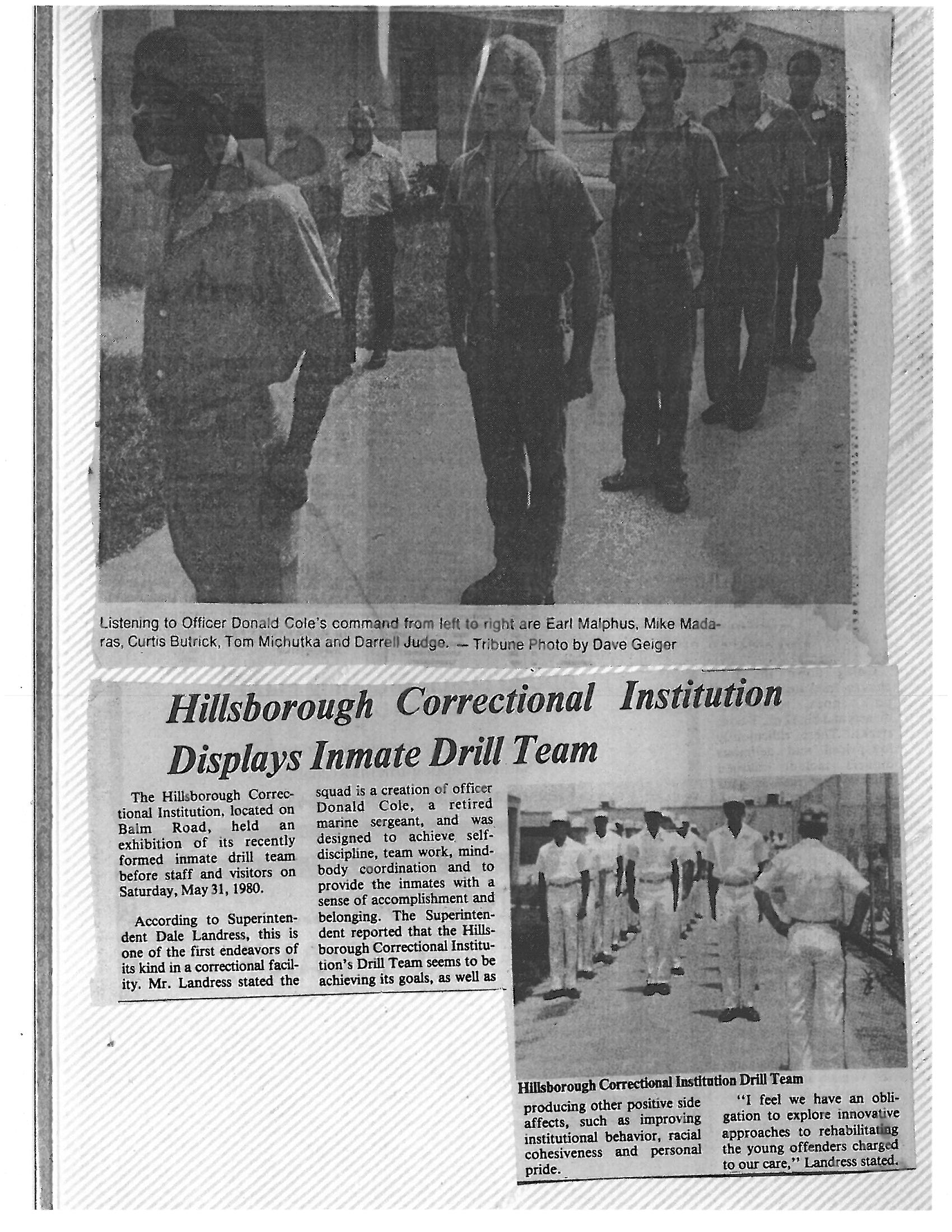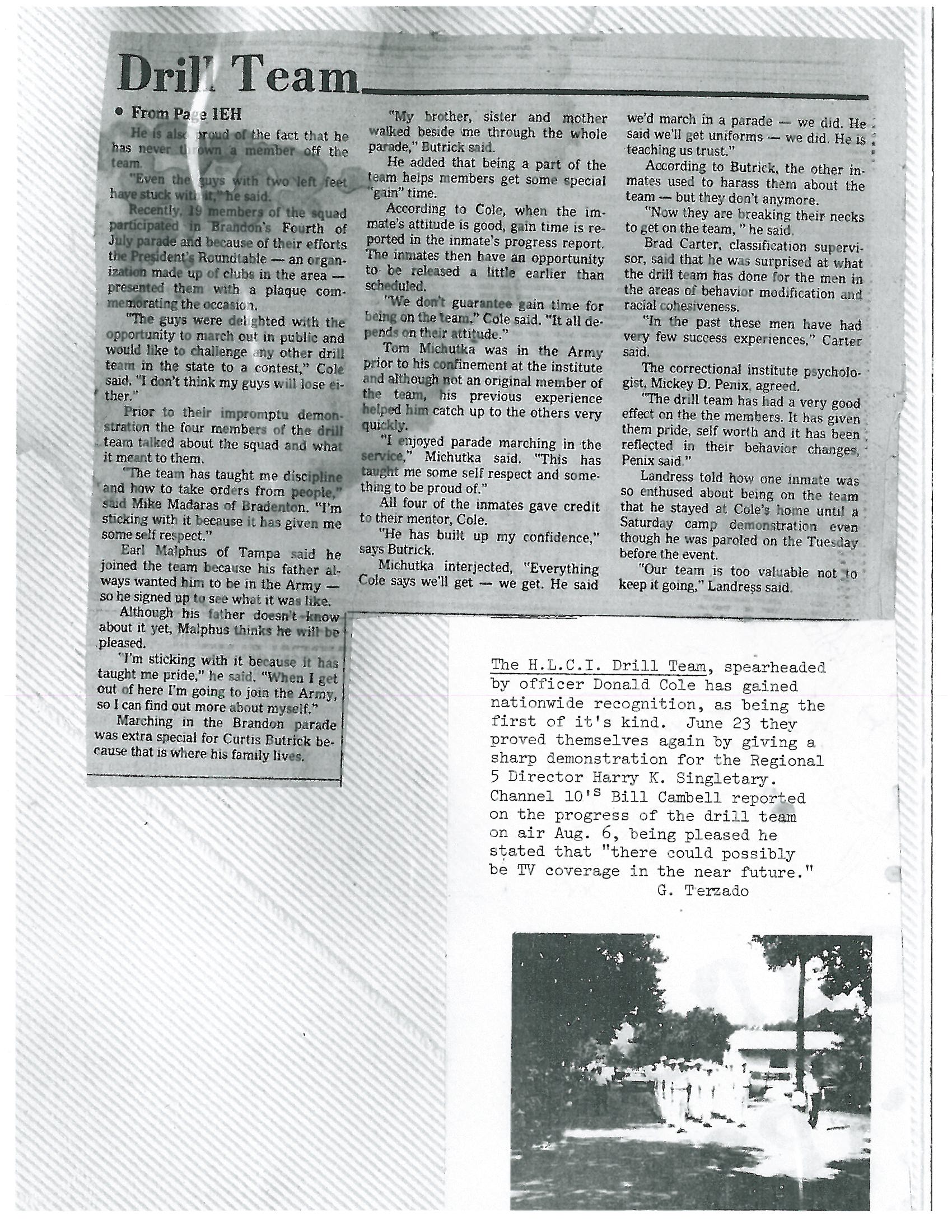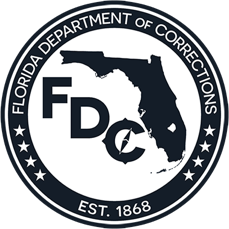Throughout 1980s
Prison admissions skyrocket with the advent of crack cocaine, outstripping prison space. On June 30, 1980 Florida's total inmate population is 19,692. By the end of the decade Florida's prison population has grown to 38,059, a 93% increase during the decade.
1980
INMATE POPULATION JUNE 30, 1980: 19,692
Offender Based Information System (OBIS): New databases implemented this year include the Application System Inventory (ASI) and Inmate Custody Classification (batch mode only) systems.
FIRST INMATE DRILL TEAM
Created at Hillsborough CI. A first-of-its-kind inmate drill team is organized at Hillsborough Correctional Institution in 1980. Sgt. Donald Cole, a retired Marine Sergeant, is the driving force behind it. The team participated in numerous local parades and events, including parades in Brandon, Wimauma-Balm, Ruskin and even Tampa's Gasparilla Parade. The drill team was a source of pride for Hillsborough CI's staff and inmates, and Sgt. Cole earned accolades from former Governor Bob Graham and former Secretary Louie L. Wainwright for his efforts.
Click images for larger view.
10 INMATES ESCAPE FROM FLORIDA STATE PRISON THROUGH
HOLE IN RECREATION YARD FENCE
On August 5, ten inmates at Florida State Prison attempted the largest prison break in Florida Department of Corrections history. According to an article in the Miami Herald on August 7, 1980, "Two of the escapees were caught almost immediately after they tried to follow the original group of six through holes cut in two 12-foot-high chain-link fences around 6:15 Tuesday. The other two were caught shortly before midnight behind a prison cemetery at nearby Union C.I." A fifth was caught at 11:30 p.m. four miles away, and nine days later two more were caught during an armed robbery in Indiana. More than 100 law enforcement officers, using bloodhounds and assisted by helicopter, participated in the hunt for the escapees. The three remaining escapees were Kenneth David, who was returned to prison on October 1, 1980; James Shearer, who was returned to prison on October 24, 1980 and later paroled; and Harvey McElroy, who died on January 21, 1981.

In this AP photo from 1980, Norman DesPres, right, and Charles Daniel, two of the 10 who escaped from FSP, are recaptured the same night. Interestingly, while searching for the escaped prisoners, sheriff's deputies discovered a marijuana field of an "enormous size" and arrested one man as a result. The deputies became suspicious when the man, holding a shotgun, screamed at them to get off his property.
Shearer, who had three previous prison escapes under his belt, had been running about 15 miles a day to get in shape, according to an August 7, 1980 story in the Florida Times Union. The article also said "In 1973, he escaped from the reception and medical center at Lake Butler and was gone for 24 days. It was a wild three weeks. Shearer made it as far as Tallahassee that time, where he stole an International Scout that was parked at the Tallahassee airport with the keys in it. The car happened to belong to Department of Corrections Secretary Louie Wainwright." In fact, it was Secretary Wainwright’s son’s car.
Numerous improvements have been made to the perimeter at FSP in the past 20 years, not the least of which are rolls of razor wire and ribbon around the perimeter fences. The 21-year-old correctional officer who should have seen the inmates go through the recreation yard fence was fired for gross negligence.
Officer Richard J. Burke is stabbed to death on October 12, 1980, at Florida State Prison, as he is escorting Death Row inmates from their cells to the shower.
During a two-week period in October, Florida State Prison (FSP) has some of its darkest days. At FSP, one correctional officer is stabbed to death by an inmate. Another is stabbed, but survives. Two more are taken hostage by an inmate, releasing them only after he is shot by another officer. (That officer's expert marksmanship would come in handy in another hostage situation the following year.) And in two separate incidents, officers suffer burns when inmates light rubbing alcohol and another substance and throw them on the officers. Throughout the week, inmates are intentionally flooding their cells, throwing their food trays at officers and inmate runners who deliver meals, and ultimately breaking windows and burning mattresses. Through the use of pepper foggers, mace, shields and backup officers, the prison gradually returns to normal.
FSP, OCTOBER 1980
On Sunday, October 12 at 5:50 p.m. Correctional Officer Richard J. Burke is escorting Death Row inmates from their cells to the shower. Officer Burke is suddenly attacked by inmate Thomas Knight, who uses a serving spoon handle sharpened on one end to stab the officer numerous times in front of both inmates and two other officers. Sgt. H.J. Owens orders Knight to back away from Officer Burke; Knight does so.

Correctional Officer
Richard J. Burke
Knight drops the weapon in a trash box. The handle end of the weapon is wrapped in what appears to be strips of sheet. Officer Burke sustains several stab wounds, the most serious being in the chest and middle of the back. He is pronounced dead at 6:10 p.m. by Dr. Dionisio Britton at Florida State Prison. The prison chaplain drives to his home in nearby Orange Park to notify his family. It is subsequently learned that inmate Knight was upset because his visitation was cancelled when he refused to shave prior to the visit. He allegedly stated that he would "just have to start sticking people." Thomas Knight receives another death sentence and it will be another 34 years before he is executed, on January 7, 2014. Knight spent a total of 39 years on death row, longer than any other inmate executed in Florida.
As a result of Officer Burke's death, the following day FSP Superintendent Clayton G. (Sonny) Strickland orders that all inmates in the lockdown area of FSP be handcuffed for all out-of-cell movement. He feels this necessary to maintain effective security and control of the inmates, given the circumstances. That night inmates decide to "buck up" against the handcuff movement order by simultaneously flooding their cells. This is done by stuffing and continuously flushing toilets in the individual cells. Staff reacts by turning off the water. It was turned back on later that evening when the inmates settle down.
The next day, Tuesday, October 14 at about noon inmates are loud and boisterous, catcalling to correctional officers and attempting to intimidate the inmate runners delivering food, in part because outside activity (including exercise) has been curtailed until after the funeral of Officer Burke. At around noon, Assistant Superintendent Richard Dugger (who later becomes Secretary of the Department) and Colonel Tom Barton (who later becomes Superintendent at FSP) are informed that inmates are throwing their food trays on the floor. Runners are withdrawn from serving food. Flooding of cells begins again. Asst. Supt. Dugger alerts other staff to the possibility of trouble. Officers talk with inmates, trying to calm the situation. It isn't working. Inmates are now throwing debris out into the serving areas and using the debris to break windows. Forty inmates have still not been served lunch. When staff takes over the feeding, inmates throw food and the trays at the officers. Colonel Barton goes to the arsenal to get riot gear and Asst. Supt. Dugger goes to the dining hall to assemble staff. Some small fires have been spotted in cells. Asst. Supt. Dugger attempts one last time to calm the inmates with a final offer that their noon meal would be served if they calm down. The catcalls and riotous activity continue. Subsequently, a "show of force" is made, in which teams of officers in full riot gear make their presence known to the inmates and pepper foggers are prepared. This too is unsuccessful, as the noise, verbal abuse and disruption continue. As a last resort, the Superintendent orders that certain tiers be pepper fogged. Supt. Stickland also requests that two additional alert squads from UCI be mobilized. The squads are assembled.
Inmates continue rioting and the pepper fogger is then used on the tiers that were not sprayed the first time. Order begins to be restored. Inmates are showered and given clean clothes. Medical staff checks each inmate. While they are in the showers, a shakedown of each of their cells takes place to find weapons. All but 25 of the 86 windows on the north side of P wing have been broken. Count is taken. Showering of inmates is completed, the area cleaned of all debris, swept and mopped out. One officer is injured when he cut his hand on broken glass, and five inmates complain of eye or throat problems from the pepper fogger. There are no incidents reported after the serving of the evening meal.

"Prison Violence Erupts," "Bloody Sunday," and other headlines appear in the newspapers.
Wednesday, October 15, 1980
12:30 p.m.
Memorial services are held for Officer Burke.
1:30 p.m.
One hour later, CO I Howard Howland is stabbed by inmate Gary Trawick. His weapon is a long mop handle in which had been inserted a sharpened round bar from a mop bucket. Officer Howland sustains a partially collapsed lung, but he survives. In April 2023, Trawick is still serving a life sentence.
5:20 p.m.
Death Row inmate Steven Booker throws a cup of lighted rubbing alcohol on CO Marvin S. Thomas. The officer is taken to the hospital for observation. Booker died in prison on November 3, 2022.
5:30 p.m.
Inmates begin to riot again, throwing objects at staff. After verbal instructions to cease are ignored, the pepper fogger is used on inmates on S, V, and T wings. Order is restored, all inmates are showered, issued clean clothes and checked by medical staff.
Thursday, October 16, 1980
7:30 a.m.
Aided by two squads from Union C.I. and one from Lawtey C.I., Colonel Tom Barton begins a complete shakedown of FSP. Several weapons are recovered, including 40 homemade knives. The state attorney is asked to prosecute. Two officers report being threatened.
Saturday, October 18, 1980
An inmates throws a glass jar at one officer, another is kicked in the right thigh.
Sunday, October 19, 1980
When ordered to move from P to S wing, Inmate Earine Jackson objects. When ordered to move again, he takes a cup of Magic Shaving Powder and water solution and throws it in Sgt. B.J. Jarvis' face. (Magic Shaving Power is a type of hair removal solution that is caustic when mixed with water. Inmates with sensitive skin used it instead of razors.) Sgt. Jarvis receives severe burns on the left side of his face and shoulder. The inmate is moved to S wing. He died on April 1, 1997 at another prison.
Monday and Tuesday, October 20-21, 1980
Several incidents occur involving threats, attempted assaults and assaults on prison staff, including a prison investigator.
Sunday, October 26, 1980
8:30 p.m.
While in the process of showering inmates on S wing, Correctional officers Robin Faulk and Joseph Shappard are taken hostage by inmate Steven Thomas, who is armed with a homemade knife. Thomas handcuffs both officers and puts them in his cell. He also strikes Officer Faulk over the left eye. Superintendent Strickland, Asst. Supts. Dugger and David Watson, and Colonel Tom Barton are notified and proceed to S wing. The lights have been extinguished and it is dark. They shine flashlights on the inmate and observe the knife in his left hand. The suspect is ordered to drop the knife and surrender, to which he responds "If you come down the row I'll kill both officers." The inmate also tells them not to come any closer. They advance, and the inmate runs down the gallery at them with his left hand raised. The knife is in that hand, tied to his wrist so he can't lose it. Colonel Barton tells Thomas to halt, Thomas doesn't and Barton fires one round of buckshot from his 12-gauge shotgun, wounding Thomas in the lower left side. Barton then approaches Thomas and tells him to give up the knife, which he does. They then handcuff him and get him to medical. Thomas is listed in stable condition. The officers, who sustain cuts and bruises, are treated and released. Thomas was paroled on September 15, 1998.
 Click here to hear Secretary Dugger discuss the day FSP staff regain control of the institution.
Click here to hear Secretary Dugger discuss the day FSP staff regain control of the institution.
 Click here to hear Secretary Dugger discuss a hostage rescue with FSP Chief (later Warden) Tom Barton.
Click here to hear Secretary Dugger discuss a hostage rescue with FSP Chief (later Warden) Tom Barton.

Inmates of Lantana Correctional Institution building a ramp enabling disabled children to attend the Royal Palm Elementary School in West Palm Beach.

The Lakeland Probation and
Restitution Center (PRC) in 1980-1981.
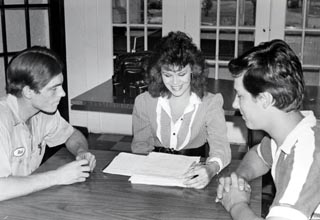
Volunteer Emily Radd (who is later a Correctional Services Consultant in Central Office) provides orientation to new Lakeland PRC residents.

A dialogue with juvenile delinquents is conducted by members of "Save-Prevent-Rehabilitate Youth" located at Tampa Community Correctional Center.
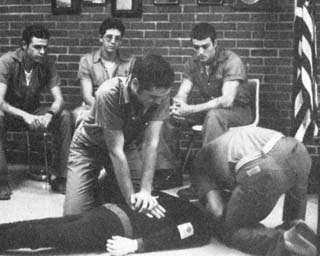
Inmates learning Cardio-Pulmonary Resuscitation (CPR) at Apalachee Correctional Institution.
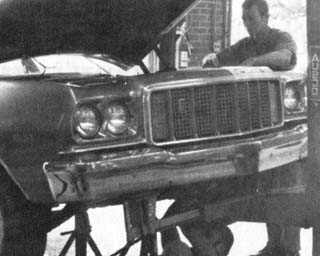
Engine repair class at Brevard Correctional Institution.
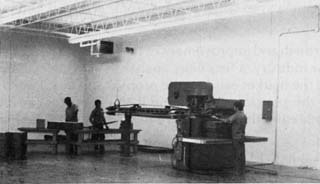
The industries box factory at Marion Correctional Institution.
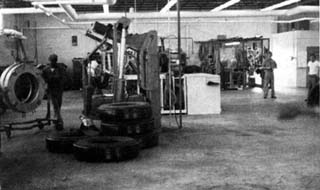
The industries recapping plant at Avon Park Correctional Institution.
- 1821-1845
- 1868-1876
- 1877-1895
- 1900-1919
- 1921
- 1922-1924
- 1927
- 1928-1931
- 1932 | CHAPMAN
- 1933-1935
- 1936-1939
- 1940-1945
- 1946-1949
- 1950-1955
- 1956-1961
- 1962 | WAINWRIGHT
- 1963-1965
- 1966-1969
- 1970-1975
- 1976-1979
- 1980-1986
- 1987 | DUGGER
- 1988-1990
- 1991 | SINGLETARY
- 1992-1995
- 1996-1998
- 1999 | MOORE
- 2000-2002
- 2003 | CROSBY
- 2004-2005
- 2006 | MCDONOUGH
- 2007
- 2008 | MCNEIL
- 2009-2010
- 2011 | BUSS
- 2011 | TUCKER
- 2012 | CREWS
- 2013-2014
- 2014 | JONES
- 2015-2018
- 2019 | INCH
- 2020-2021
- 2021 | DIXON
- 2022-Today
- Population Summary Table

